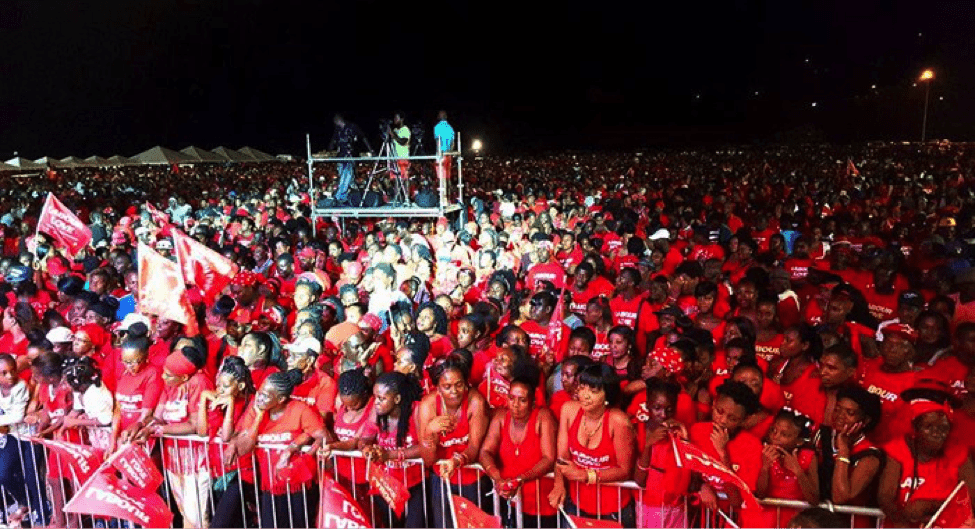The views expressed herein are those of the writer and do not represent the opinions or editorial position of I-Witness News. Opinion pieces can be submitted to [email protected].
A “cargo cult” is a millenarian movement encompassing a diverse range of practices generated in reaction to European colonization and its aftermath. It was reported as first occurring in the colonised countries of the Pacific region of Melanesia. The name derives from the belief that various ritualistic acts will lead to the bestowing of material wealth (“cargo“) (all references and quotes are from an excellent Wikipedia summary.
Cargo cults developed in response to economic crises or prolonged economic stagnation, often under the leadership of a charismatic figure. This leader may have a “vision” of a future characterized by untold prosperity or renewed growth based on an Europeanised view of Karl Marx’s idea of “commodity fetishism”.
There is no better example of commodity fetishism than our current addiction to cell phones, especially their Internet-ready variety, in the way they have replaced face-to-face interaction; in how smart phones are easily exchanged for sex with adolescent girls and boys; and the manner in which onanistic phone sex has replaced the “real thing” for some elderly men.
Cargo cults are marked by a number of common characteristics, including the use of religious imagery; the expectation of help from foreigners; the presence of charismatic leaders; and the promise of the sudden appearance from outside of huge sums of money and/or goods.
Sound anything like the Argyle International Airport (AIA) project in St. Vincent and the Grenadines (SVG)?
The indigenous societies of Melanesia were typically characterised by a “Big Man” political system. A Big Man achieves his position through hard work, ambition, outstanding oratorical skill, cleverness, and generosity. He amasses a large group of followers, both from his clan and from other clans. He provides his followers with protection and economic assistance, in return receiving support, which he uses to increase his status. Big Men gain prestige by generating and giving away a lot of wealth, something that enhances their renown and the dependence of people on them for their livelihood.
Sound like anyone we know?
Symbols associated with Christianity and modern Western culture are blended with local rituals. A notable example of cargo cult activity was the construction of mock airstrips and airports where various ceremonies were routinely held.
Sound familiar?
The most widely known period of cargo cult activity occurred among the Melanesian islanders in the years during and after World War II. For the first time, indigenous peoples witnessed close up the largest war ever fought by technologically advanced nations. The Japanese arrived first with a great deal of supplies. Later the Allied forces followed suit.
“The vast amounts of military equipment and supplies that both sides sent to their troops on these islands meant drastic changes to the lifestyle of the islanders. Manufactured clothing, medicine, canned food, tents, weapons and other goods arrived in vast quantities for the soldiers, who often shared some of it with the islanders who were their guides and hosts.”
Our own Vincentian parallel has been the tremendous wealth in the form of remittances, barrels and containers, savings, investments, and pensions from thousands of migrants to Trinidad, Aruba, Curacao, England, America, Canada, and elsewhere beginning in the 1930s and continuing up to the present, a process that has left those who have not benefited from this wealth feeling relatively worse off, thereby enhancing their desire for “cargo” of their own.
“With the end of the war [in the Pacific] the military abandoned the airbases and stopped dropping cargo. In response, charismatic individuals developed cults among remote Melanesian populations that promised to bestow on their followers deliveries of food, arms, Jeeps, etc. The cult leaders explained that the cargo would be gifts from their own ancestors, or other sources, as had occurred with the outsider armies. In attempts to get cargo to fall by parachute or land in planes or ships again, islanders imitated the same practices they had seen the soldiers, sailors, and airmen use. Cult behaviours usually involved mimicking the day-to-day activities and dress styles of US soldiers, such as performing parade ground drills with wooden or salvaged rifles. The islanders carved headphones from wood and wore them while sitting in fabricated control towers. They waved the landing signals while standing on the runways. They lit signal fires and torches to light up runways and lighthouses.”
The cargo never came.
Apart from the different cultural context, the symbolism and activities of the Melanesian cargo cults is hauntingly similar to those of Argyle: thousands of people gathering at a mock airport engaging in tightly structured ceremonies mimicking the arrival of big jet planes from distant places full of cargo-bearing tourists.
If the symbolic quasi-magical act of flying small planes full of lesser Big Men from Arnos Vale to an unfinished shrine in the middle of nowhere on the Windward coast of SVG doesn’t sound like the rituals carried out in Melanesia, consider the overarching parallel to our fetishistic craving for more and more cargo notwithstanding stagnant or declining economic conditions, including the slow and painful death of agriculture, and fewer migration opportunities in recent years (except for those with or seeking advanced education).
These conditions called for a new source of cargo, one advanced by our very own Big Man: the building of AIA based on a 2005 “vision” that such an undertaking would bring hundreds of thousands of cargo-bearing visitors.
Cargo cults were typically created by individual Big Men in Melanesian culture, and it is unclear whether these leaders were sincere or just scamming their gullible people since the leaders typically held ceremonies far from established towns and the prying eyes of colonial authorities.
Again, this sounds like bringing in small Arnos Vale aircraft to land at Argyle on two different occasions and proclaiming to enthralled cargo cult adherents (also know as ULP supporters) that this was proof that an airport financed by what turned out to be a mythical “coalition of the willing” would be a resounding success.
The term cargo cult has been used metaphorically — as I use it here — to describe an attempt to fabricate or reinvent successful outcomes — in our case bringing in hoards of moneyed tourists — by duplicating circumstances associated with those outcomes — in our case building a phantom airport at Argyle — even though those circumstances (an international airport) are either unrelated to the causes of the outcomes or insufficient to produce them by themselves (international airports are almost always a response to increased travel demand, not the other way round).
Economist Bryan Caplan has referred to Communism as “the largest cargo cult the world has ever seen”, calling the economic strategy of 20th-century Communist leaders as “mimicking a few random characteristics of advanced economies”, such as the production of steel.
I contend that our Big Man Ralph Gonsalves’ construction of AIA outshines the example of communist steel production or false Soviet five-year plans as parts of a larger cargo cult. This is because AIA represents a hyper-mimicking of “a few random characteristics of advanced economies” by employing the airport as both a symbol of this development and as the means to attain its material benefits.

Ecstatic quasi-religious ceremonies packed with people symbolically clad in red lead by a scripture-quoting charismatic leader who has missed no opportunity to hold one crusade after another over the past 10 years (and three in the past few weeks) to enhance his status as our country’s great provider (Big Man) and visionary leader at the mock airport at Argyle where he has repeatedly promised untold wealth (“cargo”) when the project finally becomes operational show all the signs of a contemporary Caribbean cargo cult.
Novelist Chinua Achebe in his 1984 book The Trouble with Nigeria criticized what he called the “cargo cult mentality” of the rulers of many developing countries who make high sounding proclamations about the future of their countries but fail to bring about those improvements.
As in Melanesia, our cargo will never come.
***
This is the 20th in a series of essays on the folly of the proposed Argyle International Airport.
My other AIA pieces may be found at:
- Get ready for a November election!
- Lessons for Argyle Airport from Canada’s Montreal–Mirabel Int’l
- Lessons for Argyle Int’l Airport from the cruise industry
- Lessons from Target Canada for Argyle Int’l Airport
- Lessons from Trinidad & Tobago for Argyle Int’l Airport
- The Dark Side of Tourism: Lessons for Argyle Airport
- Why Argyle Won’t Fly: Lessons from Dominica
- Ken Boyea and the Phantom City at Arnos Vale
- Airport Envy Vincy-Style
- Fully realising our country’s tourism potential
- Airport without a cause
- The unnatural place for an international airport
- The Potemkin Folly at Argyle
- False patriotism and deceitful promises at Argyle
- Airport politics and betrayal Vincy-Style
- Phony airport completion election promises, Vincy-style
- Is Argyle Airport really a ‘huge game-changer for us?’
- Has the cat got your tongue, Prime Minister?
- More proof that Argyle won’t fly
C. ben-David
The opinions presented in this content belong to the author and may not necessarily reflect the perspectives or editorial stance of iWitness News. Opinion pieces can be submitted to [email protected].





